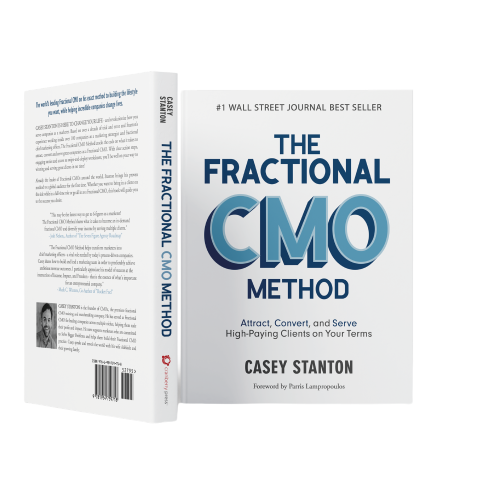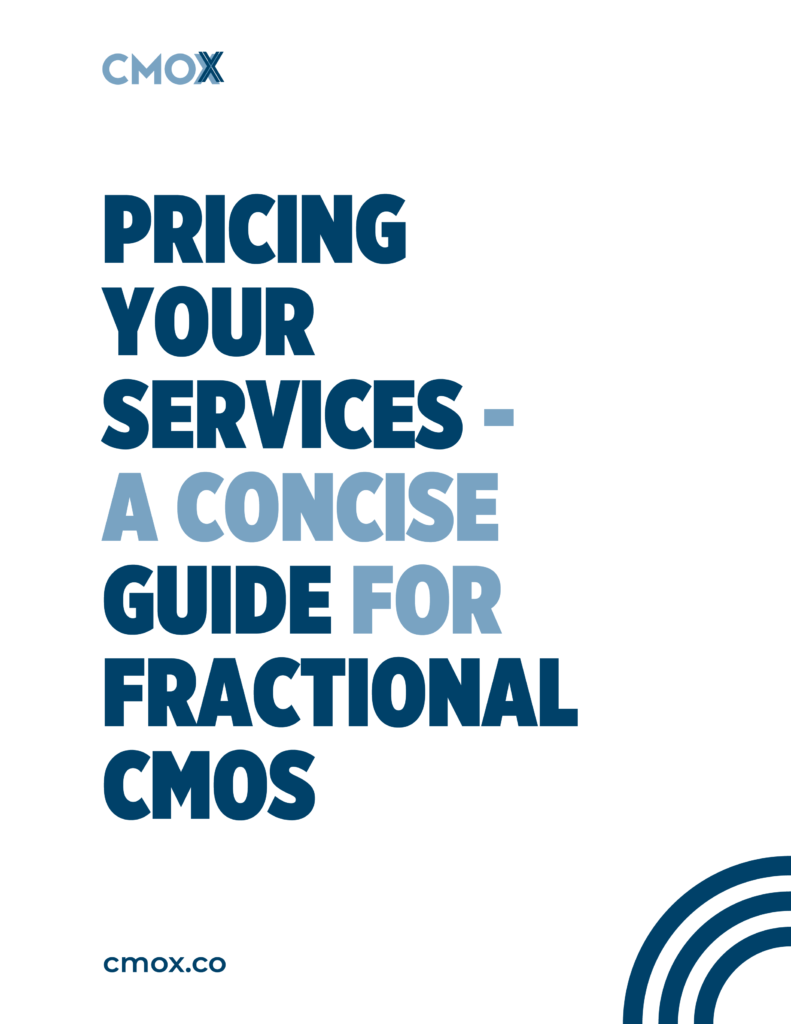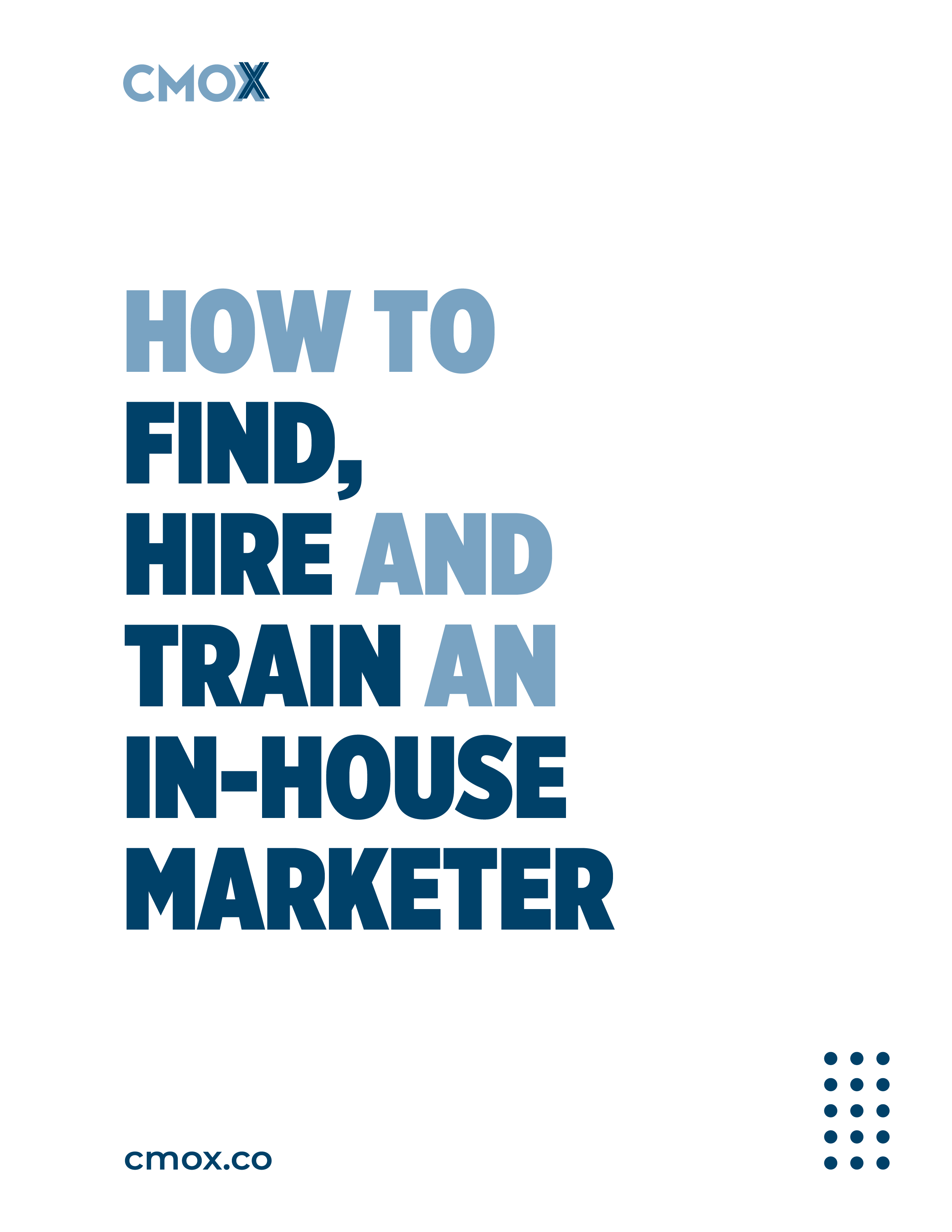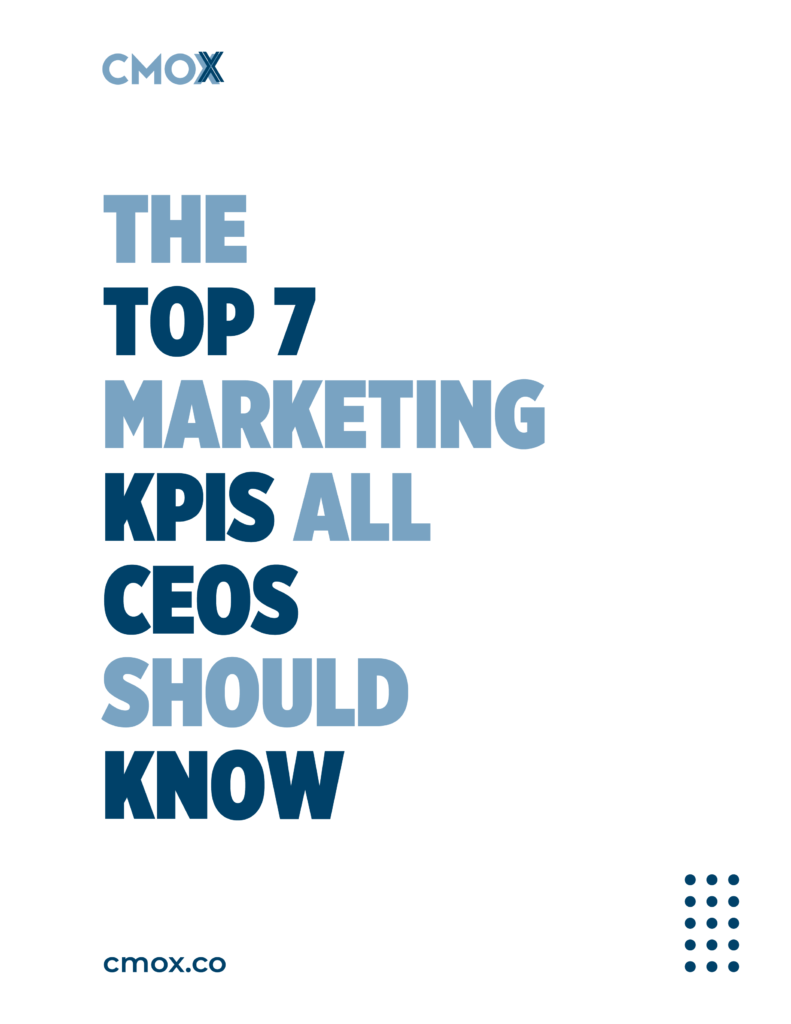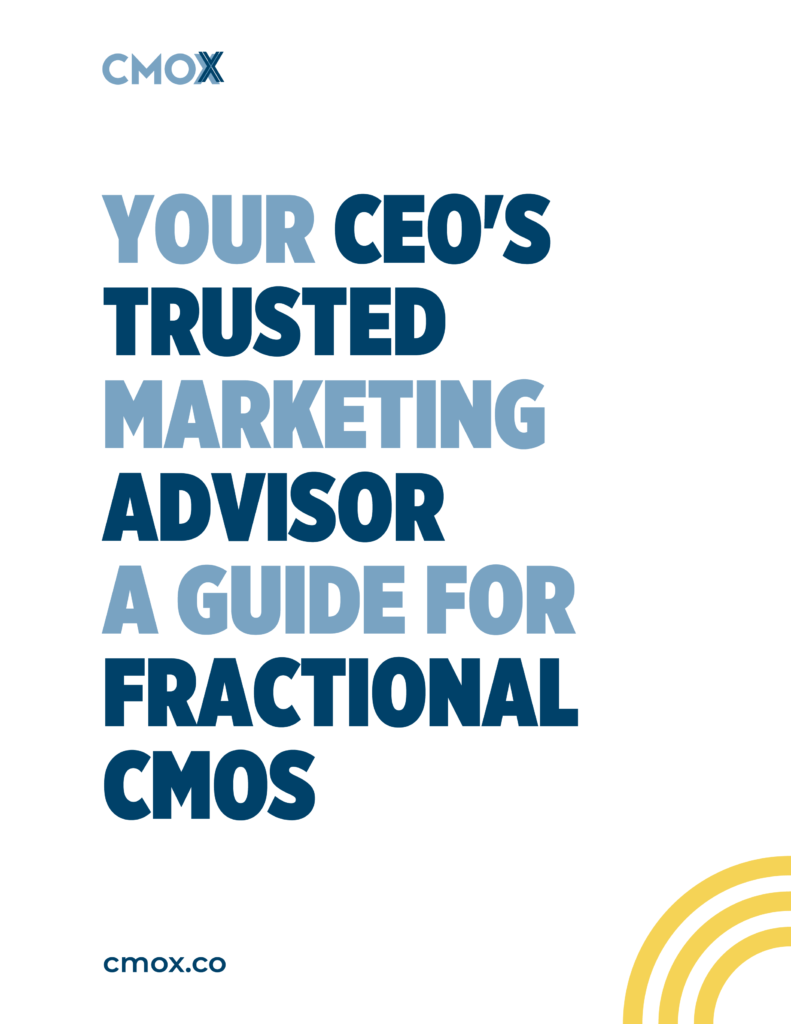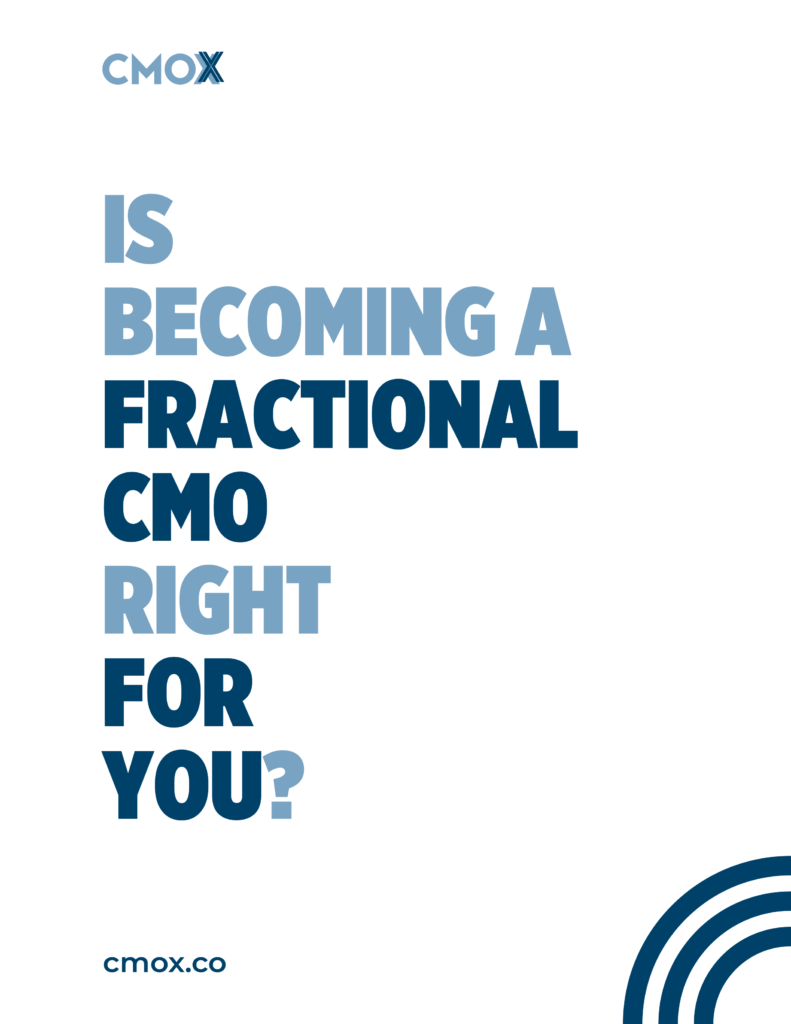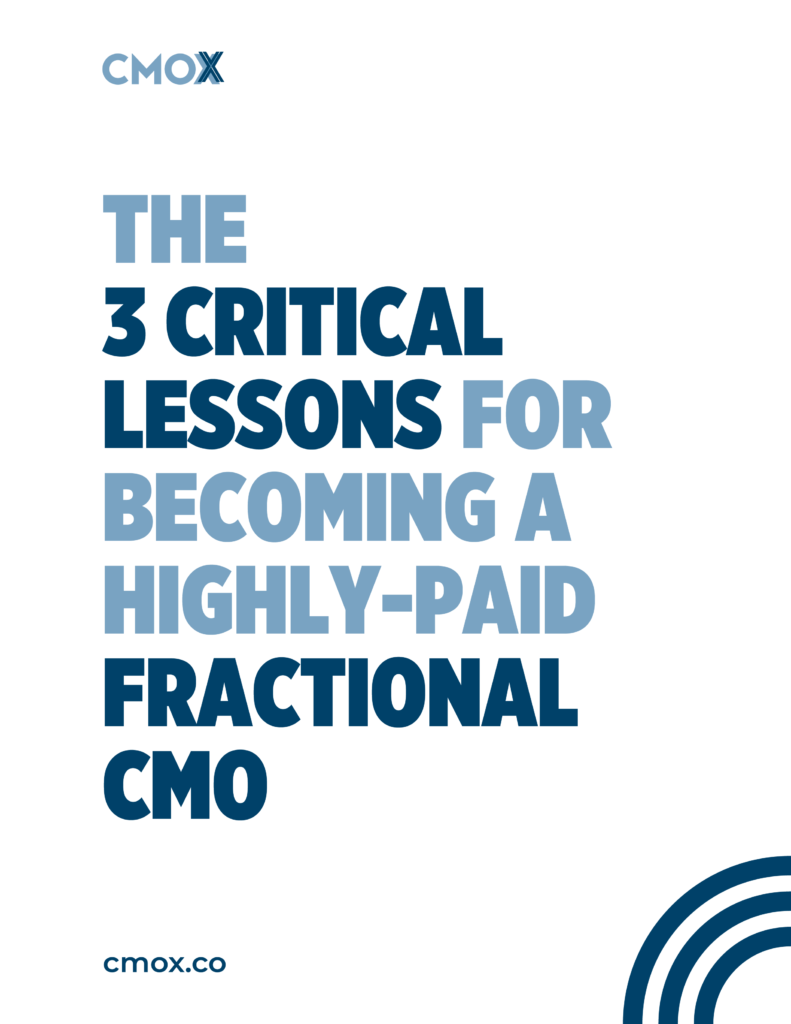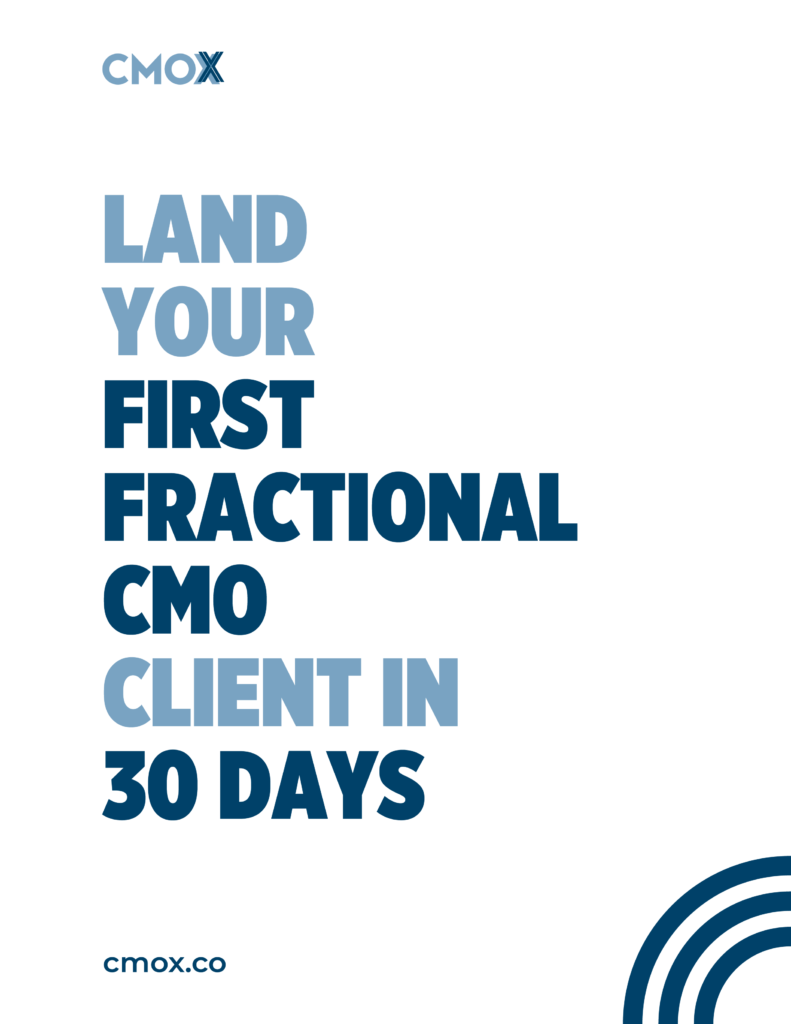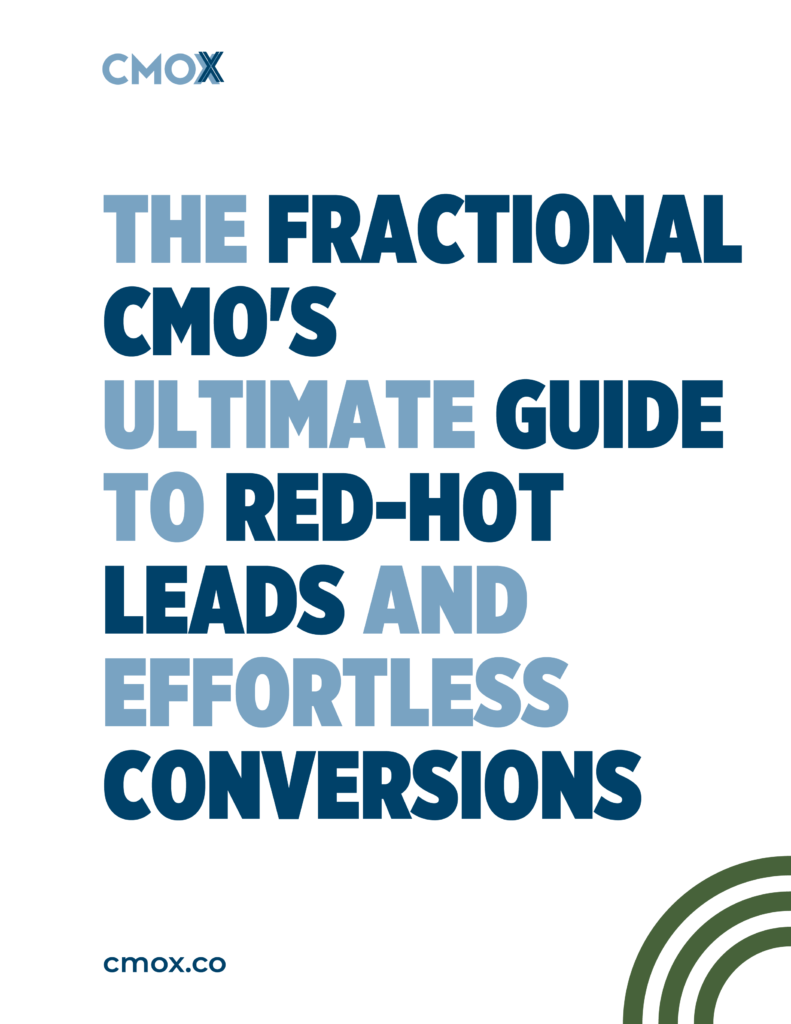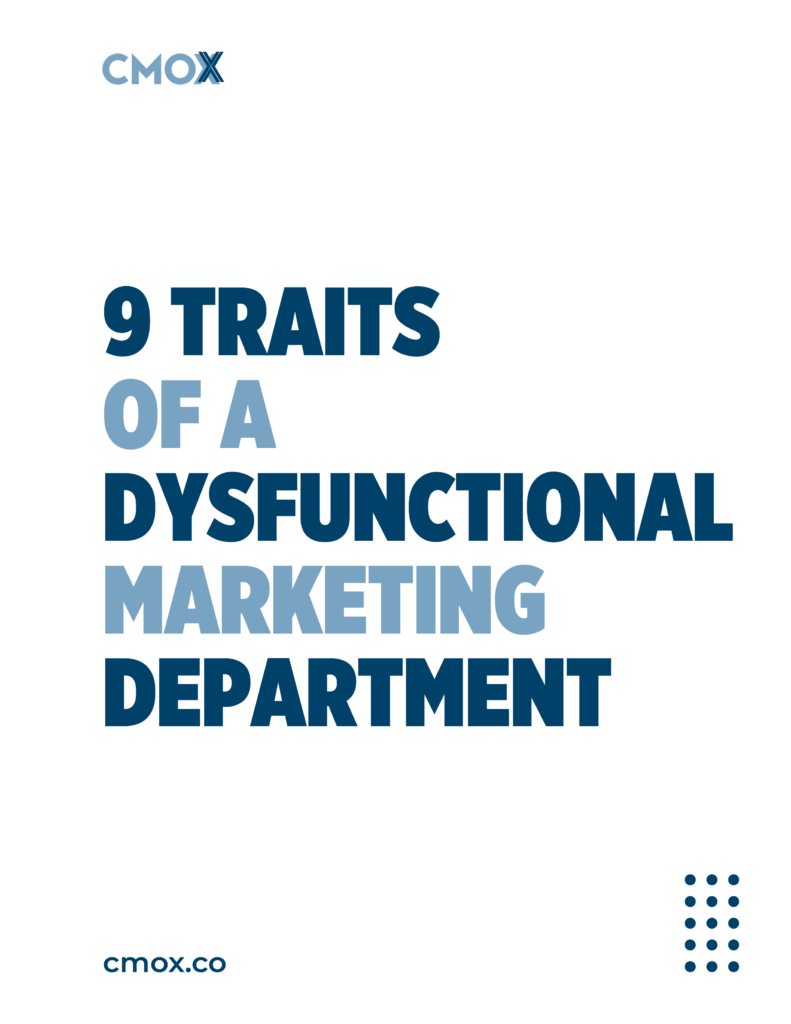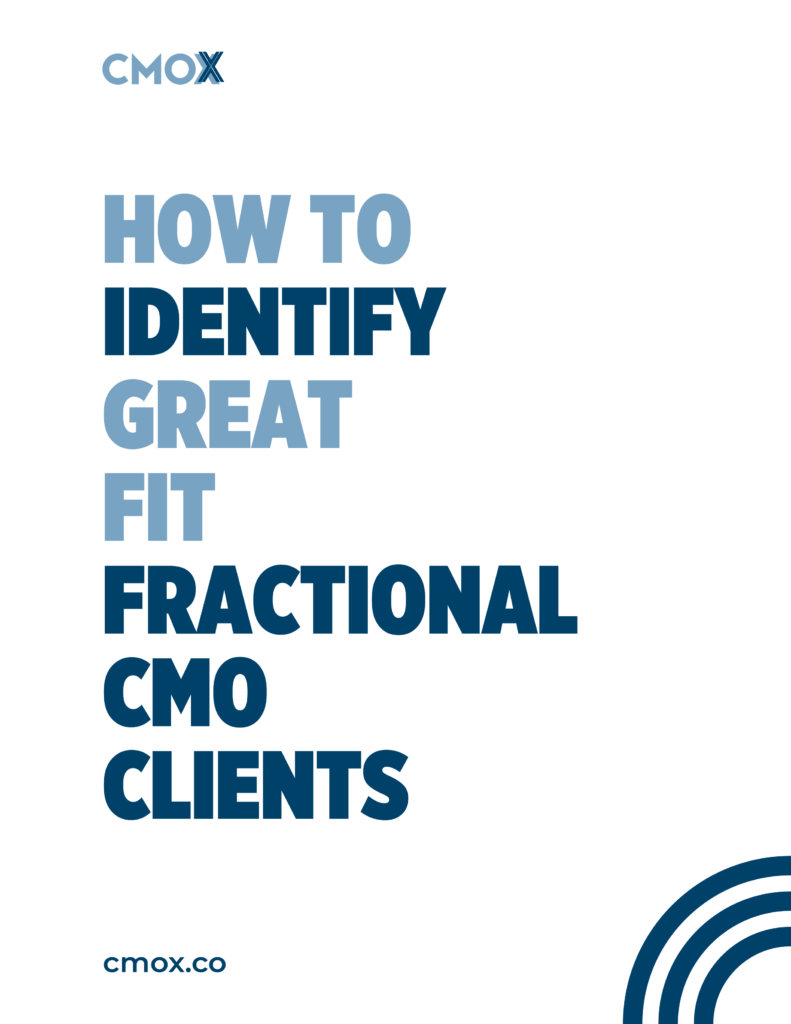Choosing the right marketing team structure can feel overwhelming, especially for small to mid-sized business owners navigating growth and evolving marketing demands. With so many options, it’s critical to choose a structure that aligns with your company’s goals, available resources, and customer base.
This guide explores different ways to structure your marketing department, the benefits of each, and practical steps to build a team that supports your business objectives. Whether you’re a startup with limited bandwidth or a growing business ready to scale, this resource will help you build an agile, results-driven marketing team structure designed for long-term success.
Are you ready to build a high-performing team?
Learn how CMOx provides small and mid-sized businesses with experienced fractional CMOs who know how to develop and organize effective marketing departments. Discover proven strategies and best practices to help you design a marketing team structure that drives real growth.
Key Takeaway
- There are multiple types of marketing team structures, and choosing the right one depends on your business’s goals, size, and available resources.
- Sub-structures may be necessary depending on your marketing priorities (e.g., paid media vs. SEO vs. traditional advertising).
- Small and mid-sized businesses often benefit from lean, cross-functional teams—but growth calls for specialization.
- Building the right team takes time, but following a structured approach makes the process more strategic and less overwhelming.
Selecting the right marketing team structure is essential to ensuring your team operates efficiently and contributes meaningfully to your bottom line. Different models support different business models — from product-driven startups to service-based agencies. No matter the approach, your team structure should encourage collaboration, build in areas of specialization, and adapt to changing market dynamics.
Regularly reviewing and adjusting your marketing structure will ensure your team remains aligned with business goals.


How to Identify Great Fit Fractional CMO Clients
- What size marketing department your ideal client needs to have
- The secret of low-stress client services
- What prospective clients can be a home-run for you (and who you should steer clear of!)
- Strategies to evaluate start-ups and nonprofits
- How to protect your reputation
Social Media Marketing
The social media team is responsible for creating and executing strategies across platforms like Facebook, Instagram, LinkedIn, and X (formerly Twitter). They track engagement, grow audience reach, and ensure your brand stays relevant in the digital conversation.
Key responsibilities:
- Develop and execute social strategies
- Create engaging visuals and written content
- Monitor trends and conversations
- Analyze post performance and adjust tactics
Organic / SEO
Your SEO team focuses on increasing your website’s visibility in search engines. They conduct keyword research, optimize on-page and technical SEO elements, and collaborate with content creators to improve rankings.
Core activities:
- Perform keyword and competitor research
- Optimize site architecture and metadata
- Track and report on organic traffic and keyword performance
- Work with content writers on SEO-friendly content
Paid Advertising
The paid ads team manages your digital advertising strategy. They handle Google Ads, paid social, programmatic advertising, and retargeting — all with a focus on ROI.
Responsibilities include:
- Design and manage campaigns across platforms
- Develop ad creative and targeting strategies
- Monitor ad spend and optimize performance
- Generate reports on cost-per-click, conversions, and ROI
Web Design
Your web design team ensures your digital storefront is fast, responsive, and user-friendly. This team improves site usability and supports conversion goals.
Responsibilities:
- Design and maintain website layouts
- Optimize for mobile and user experience (UX)
- Collaborate on landing page creation
- Track website behavior and funnel flow
Lead Acquisition
This team focuses on growing your customer base. They drive top-of-funnel strategies and optimize the customer journey to convert visitors into leads.
Primary tasks:
- Launch lead generation campaigns
- Use CRM tools to manage prospects
- Track lead quality and conversion rates
- Collaborate with sales for handoff and nurturing
Product Marketing
The product marketing team connects your offerings with the right audience. They develop messaging, sales enablement materials, and go-to-market strategies.
Key duties:
- Define product positioning and differentiation
- Support launches with campaigns and content
- Work closely with product managers and sales
- Gather customer feedback to refine messaging
Content Marketing
The content marketing team creates blogs, guides, videos, and other resources to attract, educate, and convert your audience. They collaborate with SEO, social media, and brand teams.
Responsibilities:
- Plan and execute content calendars
- Write blog posts and long-form content
- Coordinate with designers and SEO strategists
- Repurpose content across platforms
Brand Marketing
This team ensures that your company’s voice and image are consistent and compelling. They handle storytelling, brand guidelines, and awareness campaigns.
Responsibilities:
- Develop brand messaging and visual identity
- Maintain consistency across all touchpoints
- Oversee creative assets and brand campaigns
- Align internal teams to brand values
Traditional Marketing
Traditional marketers manage offline efforts — including print, direct mail, radio, and events. They integrate these with digital campaigns for a well-rounded strategy.
Core functions:
- Plan and buy traditional media placements
- Design print and out-of-home campaigns
- Track offline-to-online performance
Ensure message consistency across channels
Role of the Head of Marketing in Building a Marketing Team
The head of marketing — whether a full-time CMO or a fractional CMO — plays a critical role in designing the right marketing team structure for your business.
They are responsible for:
- Vision and leadership: Defining strategic goals and aligning marketing activities with business objectives.
- Team building: Hiring the right people for the right roles and creating a collaborative team environment.
- Skill development: Coaching team members and investing in training to keep up with trends.
- Cross-department coordination: Working with sales, product, and customer success teams to ensure alignment.
- Performance tracking: Setting KPIs and reviewing data to optimize outcomes.
- Budget and resource allocation: Prioritizing spend to maximize impact.
- Innovation: Encouraging creative problem-solving and testing new marketing technologies or approaches.
- A strong head of marketing sets the tone for team culture and ensures marketing drives revenue, not just visibility.
Identifying Your Business’ or Clients’ Needs
Before building out your marketing team structure, it’s critical to assess the specific needs of your business or clients. This ensures that your team’s skills, tools, and roles are aligned with the outcomes you’re trying to achieve.
Steps to define your marketing needs:
- Clarify business objectives: Are you focused on brand visibility, sales growth, launching a new product, or breaking into new markets?
- Understand your audience: Develop customer personas using market research, behavior data, and feedback.
- Select your channels: Prioritize marketing channels that match where your audience spends time — email, search, social, video, or offline.
- Map required skills: Identify which marketing skills are essential to achieving your goals — from SEO to analytics to content creation.
- Assess resources: Know your hiring budget. Decide whether to hire in-house, contract freelancers, or use an agency partner.
- Plan for growth: Ensure your team structure can scale as your marketing needs and business grow.
Business Size Affects the Marketing Team’s Structure
Your marketing team structure should match your company’s size and complexity. Here’s how businesses typically evolve their marketing organization:
Small Businesses (1–5 team members)
Lean and agile, small marketing teams often consist of generalists wearing many hats. One person may manage social media, content creation, and email marketing.
Best approach: Hire flexible marketers and supplement with freelancers or agencies when needed. Use automation tools to increase efficiency.
Medium-Sized Businesses (6–15 team members)
With growth comes specialization. Mid-sized businesses benefit from roles such as SEO specialists, paid media managers, and content creators working under a shared strategy.
Best approach: Build out core functions (SEO, content, PPC, analytics) while maintaining collaboration across disciplines.
Large Enterprises (15+ team members)
At scale, marketing teams become more structured with defined departments — brand, demand generation, product marketing, etc.
Best approach: Establish a hierarchy with managers overseeing key departments. Prioritize cross-functional communication and performance tracking.
What is the Best Marketing Department Structure?
The best marketing department structure is the one that reflects your business goals, customer journey, and operational realities.
There’s no one-size-fits-all model. However, the right structure:
- Enables team members to specialize
- Encourages communication between departments
- Supports accountability and measurable results
- Scales with your growth
Start simple. Optimize based on feedback, results, and team performance.
How to Build a Marketing Team to Suit Your Business
Building an effective marketing team isn’t just about filling seats — it’s about finding the right talent to drive your marketing engine. Here’s a step-by-step breakdown:
1. Identify Your Business’s Marketing Needs
Begin with a strategic audit. What are your marketing gaps and where can the biggest gains be made?
Action Steps:
- Set clear KPIs
- Prioritize functions like SEO, PPC, content, and CRM
- Consider fractional CMO support for leadership without full-time overhead
2. Determine the Right Team Structure
Select a structure that matches your business phase. Generalist roles often make sense for startups, while mid-market businesses benefit from specialist hires.
Popular structures:
- Flat (generalist)
- Specialized
- Centralized
- Cross-functional
- Hybrid
3. Where to Source Top Marketing Talent
To attract qualified marketers:
- Craft clear job descriptions
- Use top job boards (LinkedIn, Indeed, Glassdoor)
- Tap into professional associations like AMA or niche collectives
- Leverage referrals and recruiters for hard-to-fill roles
4. What to Look for in Marketing Hires
Prioritize candidates with a mix of strategic thinking, creative ability, and performance tracking experience. Cultural fit and adaptability are just as important.
5. Determine the Ideal Team Size
Use this general framework:
- Startups: 1–2 generalists
- Mid-market: 6–15, including specialists
- Enterprises: 15+, divided by function or business line
6. Essential Marketing Roles to Consider
Your marketing team structure should support your entire funnel. Key roles include:
Leadership:
- Fractional CMO
- Marketing Director
Execution:
- SEO Specialist
- Paid Media Manager
- Marketing Analyst
- Content Marketer
- Social Media Manager
- Brand Strategist
7. Onboard & Develop Your Team for Success
Set new hires up with the right tools, mentorship, and performance goals. Encourage continuous learning and collaboration across departments.
Onboarding Tips:
- Create 30/60/90 day plans
- Share brand guidelines and tools
- Offer learning opportunities (certifications, conferences)
Summary of Marketing Team Structures
Designing the right marketing team structure is a critical investment in your growth strategy. By aligning team roles with your goals, audience, and available resources, you set your business up for scalable success.
Whether you’re starting with a single generalist or building a 15-person department, the key is to stay focused, stay flexible, and continue optimizing.
Need strategic guidance or fractional CMO support?
CMOx helps growing companies build and lead winning marketing teams with tailored structures and scalable strategies.
Let us help you unlock the full potential of your marketing department.
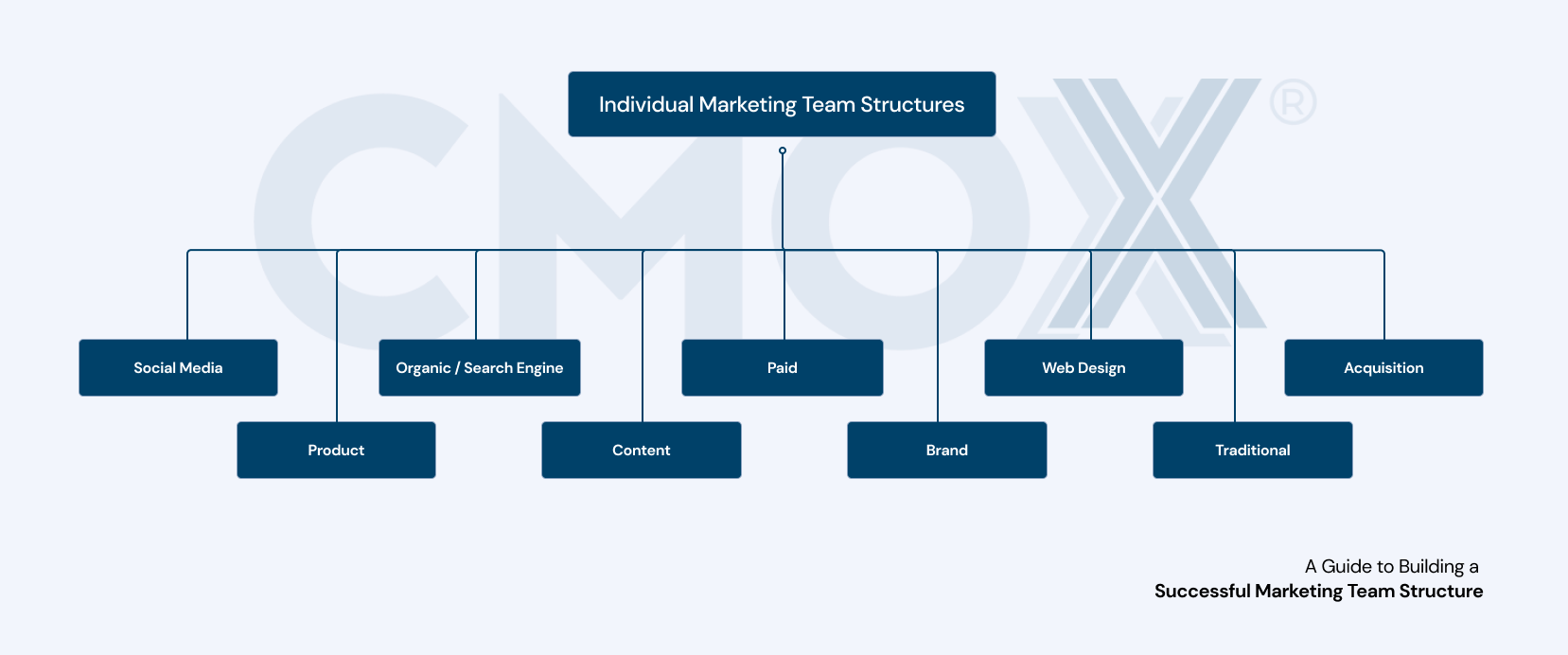
Social Media Marketing
A social media marketing manager leads a team that focuses on managing and executing marketing campaigns on various social media platforms. They are responsible for developing social media strategies, creating engaging content, monitoring social media channels, engaging with the audience, and analyzing social media performance metrics. This team keeps up with the latest social media trends and best practices to effectively promote the brand and engage with the target audience through social media channels.
Organic / Search Engine Optimization
The organic/search engine optimization team is responsible for increasing the brand’s online presence to improve organic search visibility and drive website traffic. As part of the digital marketing team, they work on search engine optimization (SEO) strategies, keyword research, content optimization, and website structure improvements. This team also focuses on content marketing initiatives to create high-quality, valuable content that attracts organic traffic and improves search engine rankings.
Paid Advertising
The paid team specializes in managing paid advertising campaigns across different digital channels, such as search engines, social media platforms, display networks, and more. They are responsible for developing paid advertising strategies, targeting the right audience, creating compelling ad copy, monitoring campaign performance, and optimizing ad spend to maximize return on investment. This team stays updated with the latest paid advertising trends, platforms, and tools to drive effective paid marketing campaigns.
Web Design
The web design team focuses on creating and maintaining an engaging and user-friendly website that aligns with the brand’s overall marketing strategy. They are responsible for website design, user experience optimization, mobile responsiveness, and overall website performance. This team works closely with other marketing teams to ensure the website effectively supports digital marketing campaigns, funnels conversions, and increases lead-generation efforts.
Lead Acquisition
The lead acquisition team’s primary focus is on acquiring new customers and expanding the brand’s customer base. They develop and execute strategies for lead generation, customer acquisition campaigns, conversion rate optimization, and tracking customer acquisition metrics. This team collaborates closely with other teams to align acquisition efforts with marketing objectives and target audiences. Oftentimes, the acquisition team will be the second or third interaction a potential customer has with the brand.
Product Marketing
The product marketing team works closely with product managers to develop strategies and campaigns for specific products or product lines. They conduct market research, identify target markets, define unique selling propositions, and develop product messaging. This team collaborates with the entire marketing team to ensure consistent product communication across various marketing channels.
Content Marketing
The content creation team is responsible for creating compelling and valuable content that attracts and engages the target audience. They develop content strategies, and produce blog posts, articles, videos, infographics, and other forms of content. This digital marketing team also ensures the content aligns with the brand voice, maintains consistency across channels, and supports SEO and social media initiatives.
Brand Marketing
The brand team focuses on developing and maintaining a strong brand identity and brand equity. They work on brand positioning, messaging, visual identity, brand guidelines, and brand consistency across all marketing touchpoints. This team collaborates with other teams to ensure the brand is effectively communicated and reflected in all marketing materials and campaigns.
Traditional Marketing
The traditional marketing team handles offline marketing channels, such as print advertising, radio, television, direct mail, and outdoor advertising. They develop strategies and campaigns for traditional media, negotiate media placements, and track the effectiveness of offline marketing initiatives. This team stays updated on traditional marketing trends and integrates traditional channels with digital marketing efforts to create a cohesive and comprehensive marketing strategy.
Role of the Head of Marketing in Building a Marketing Team
The head of marketing plays a crucial role in building a successful, modern marketing team. They are responsible for setting the strategic direction, defining goals, and ensuring the effective implementation of marketing initiatives. Broken down further, the head of marketing is responsible for guiding marketing strategies and marketing team development.
Embedded within these responsibilities are executive tasks such as the following:
- Leadership and vision: Providing leadership and a clear vision for the marketing team means establishing an overall marketing strategy, setting objectives, and communicating the direction to team members.
- Team building: The head of marketing identifies the skills and expertise required to achieve marketing goals and recruits team members accordingly. Their responsibilities include creating job descriptions, conducting interviews, and assembling a talented team of marketers.
- Talent development: Strategic marketing leaders invest in the professional development of team members. They provide training opportunities, mentorship, and guidance to help marketers enhance their skills and stay updated with industry trends.
- Collaboration and coordination: Fostering collaboration is crucial to effective coordination between each marketing team member. This practice encourages cross-functional collaboration with other departments, such as sales, product development, and customer support, to align marketing efforts with overall business objectives.
- Performance management: Setting performance metrics and regularly evaluating the team’s performance allows the CMO to build a high-performing marketing team by providing feedback, recognizing achievements, and addressing any performance gaps to ensure continuous improvement.
- Resource allocation: Allocating resources effectively is crucial in supporting marketing initiatives. Heads of marketing manage budgets, prioritize projects, and strategically allocate resources to maximize the team’s impact.
- Innovation and adaptability: CMOs and fractional CMOs should promote a culture of innovation and encourage team members to explore new marketing approaches and technologies. They stay updated with industry trends, emerging platforms, and consumer behavior to adapt marketing strategies accordingly.
Identifying Your Business’ or Clients’ Needs
To build an effective marketing team, it is crucial to identify your business or clients’ specific needs and requirements. Thoroughly understanding your business or clients’ key marketing needs allows you to tailor your ideal marketing team structure, skills, and resources to drive optimal results.
Here are some steps to help you understand your business’s marketing needs:
- Business objectives: Start by identifying the overall business objectives and marketing goals. Determine what you want to achieve through marketing, such as increasing brand awareness, driving sales, expanding into new markets, or launching new products/services.
- Target audience: Understand your target audience’s characteristics, preferences, and behaviors. Conduct market research, analyze customer data, and develop buyer personas to gain both demographic and psychographic insights into your audience’s needs and motivations.
- Marketing channels: Identify the marketing channels that are most effective for reaching your target audience. Consider both digital and traditional channels, such as social media, email marketing, content marketing, paid advertising, events, print, and public relations.
- Skill sets: Assess the marketing skills and expertise required to execute your marketing strategies effectively. Determine if you need a social media manager and specialists in areas such as SEO, content creation, data analysis, graphic design, or marketing automation.
- Resource allocation: Evaluate your budget and resources available for building a marketing team. Determine whether you can hire full-time employees, outsource certain tasks, or rely on a combination of in-house and external expertise.
- Scalability: Consider the scalability of your marketing team structure. Anticipate future growth and ensure your team can adapt to evolving business needs and industry trends.
Business Size Affects the Marketing Team’s Structure
The size of your business has a significant impact on the structure of your marketing team, as the marketing team needs to have the right components aligned with your company’s size, complexity, and goals. The marketing team structure should enable your marketing professionals to be flexible enough to adapt to changes in the market and industry landscape.
Here are some marketing department structure options based on business size:
Small businesses: In small businesses, the marketing team is often lean and multifunctional. It may consist of a few individuals who handle multiple marketing responsibilities. Cross-functional skills and versatility are key in small marketing teams, where team members may be involved in various aspects, such as social media management, content creation, and campaign execution. Small businesses may also benefit from utilizing external marketing resources from specialized agencies.
Medium-sized businesses: As businesses grow, marketing teams tend to expand. Medium-sized businesses may have specialized roles within the team, such as a dedicated social media manager, content writers, graphic designers, and digital advertisers. Collaboration and coordination between team members become increasingly important to ensure cohesive marketing efforts.
Large companies: In large companies, marketing teams are typically structured hierarchically and divided into specialized departments or units. This structure allows for greater focus and expertise in specific marketing areas. Large marketing teams may have separate teams for social media, SEO, paid advertising, content marketing, brand management, and more. Collaboration and alignment between different teams and departments are essential to maintain a consistent and integrated marketing approach.
What is the Best Marketing Department Structure?
The best marketing department structure depends on various factors, including the nature of your business, marketing goals, target audience, available resources, and industry dynamics.
There is no one-size-fits-all approach—rather, you should determine which marketing department structure aligns with your organization’s goals. It should foster communication and collaboration among your marketing professionals, maximize efficiency, and support your overall marketing strategy.
How to Build a Marketing Team to Suit Your Business
Building a high-performing marketing team is essential for business growth and brand expansion. Whether you’re launching a new department or refining an existing one, understanding how to build a marketing team is key to ensuring your marketing strategies align with your business objectives. A well-structured team enhances customer engagement, strengthens brand positioning, and drives long-term profitability.
1. Identify Your Business’s Marketing Needs
Before you start hiring, take a strategic look at your marketing goals. What are your primary business objectives? Do you need to boost brand awareness, generate leads, improve conversion rates, or strengthen customer retention? Identifying your core needs will help you determine the roles and skill sets essential for your marketing team.
Steps to Define Your Marketing Needs:
- Audit existing marketing efforts to identify gaps.
- Set clear objectives for growth and performance.
- Evaluate which marketing functions are critical to success (e.g., content creation, paid advertising, SEO, social media, analytics).
- Decide whether to hire in-house, outsource, or adopt a hybrid approach.
A strong marketing leader is key to defining strategy and building an effective team. For small businesses, a fractional CMO can provide leadership without the full-time cost, offering expertise in campaign execution, digital transformation, and market positioning.
2. Determine the Right Team Structure
Your marketing team structure should reflect your business size, budget, and growth ambitions. There are several ways to organize a marketing team, each with its own advantages.
Common Marketing Team Structures:
- Flat Structure: Generalist marketers manage a variety of tasks.
- Specialized Structure: Experts focus on distinct marketing channels (SEO, PPC, content, etc.).
- Centralized Structure: A dedicated marketing department operates as a single unit.
- Cross-Functional Structure: Marketing roles are distributed across business units.
- Hybrid Approach: A mix of in-house, outsourced, and freelance talent.
For startups and small businesses, hiring marketing generalists who can multitask across various disciplines may be the most cost-effective approach. Mid-sized and larger companies typically benefit from specialized roles with clear job functions and responsibilities.
3. Where to Source Top Marketing Talent
Building a successful marketing team starts with attracting the right candidates. Utilize multiple hiring channels to find the best fit for your business.
Strategies to Source Marketing Talent:
- Write Impactful Job Descriptions: Highlight your company’s culture, expectations, and career opportunities.
- Use High-Traffic Job Boards: Post positions on LinkedIn, Indeed, Glassdoor, and industry-specific job sites.
- Leverage Networking & Referrals: Tap into marketing groups, associations, and online communities.
- Partner with Recruiting Agencies: Consider agencies specializing in digital marketing roles.
Additionally, hiring through professional marketing organizations like the American Marketing Association (AMA) or Digital Analytics Association (DAA) can help connect you with top talent in niche areas.
4. What to Look for in Marketing Hires
When evaluating candidates, consider both technical expertise and soft skills that contribute to a high-performing marketing team.
Key Qualities of Top Marketing Talent:
- Strategic Thinking: Ability to align marketing campaigns with business objectives.
- Analytical Skills: Proficiency in data-driven decision-making and campaign optimization.
- Creativity & Innovation: Crafting compelling content and engaging brand messaging.
- Collaboration & Communication: Working effectively across departments and teams.
- Adaptability: Staying ahead of trends and evolving marketing technologies.
5. Determine the Ideal Team Size
The size of your marketing team should align with your company’s stage and growth needs. A small startup may begin with just one or two marketing professionals, while a larger organization may require a fully staffed department.
General Guidelines for Marketing Team Size:
- Startups & Small Businesses (1-5 people): A generalist marketer with broad skills in content, social media, and paid advertising.
- Mid-Sized Companies (6-15 people): Specialized roles such as SEO experts, social media managers, and PPC specialists.
- Large Enterprises (15+ people): A structured team with clear divisions, including branding, demand generation, content marketing, and data analytics.
6. Essential Marketing Roles to Consider
A well-rounded marketing team consists of a mix of creative, analytical, and strategic professionals. Consider filling these key positions:
Leadership & Strategy
- Chief Marketing Officer (CMO) or Fractional CMO – Oversees overall marketing direction.
- Marketing Director – Manages team coordination and campaign execution.
Digital & Growth Marketing
- SEO Specialist – Optimizes search rankings and website traffic.
- Paid Media Manager – Oversees PPC campaigns and paid social ads.
- Marketing Data Analyst – Tracks KPIs and customer insights.
Content & Brand Marketing
- Content Marketer – Creates blog posts, videos, and digital assets.
- Social Media Manager – Develops and executes social media strategies.
- Brand Strategist – Maintains brand consistency and voice.
By carefully selecting marketing hires based on expertise, your team can effectively execute campaigns and achieve measurable business results.
7. Onboard & Develop Your Team for Success
Once your marketing team is assembled, a structured onboarding process is critical to long-term success. Provide new hires with clear expectations, training, and growth opportunities.
Best Practices for Onboarding Marketing Employees:
- Assign mentors or peer guides for support.
- Establish 30/60/90-day performance goals.
- Provide access to marketing tools and resources.
- Encourage cross-functional collaboration with sales, product, and customer success teams.
- Offer professional development opportunities through workshops, certifications, and industry events.
Summary of Marketing Team Structures
When building a marketing team, the choices for team structures can seem overwhelming. However, the key to success lies not in simply choosing a predefined structure but in understanding how to select the best one for your business. By carefully evaluating certain factors and adapting your marketing team dynamics accordingly, you can create a well-structured and effective marketing organization that drives growth and achieves exceptional results.
Aspiring fractional CMOs (fCMOs) can access the benefits of specialized training for developing and organizing structured marketing teams. We can also connect businesses with experienced fCMOs with the skills and knowledge to optimize and oversee your entire marketing department. To further enhance your journey in building a successful marketing team, contact CMOx today.
Experience the advantages of working with CMOx and take your marketing team to new heights of success.


